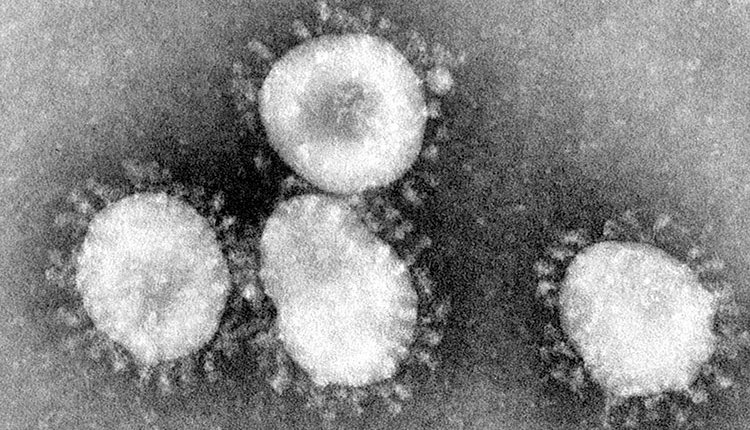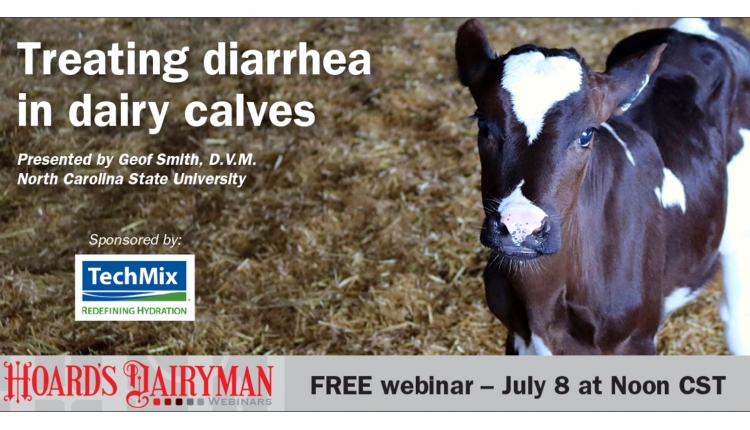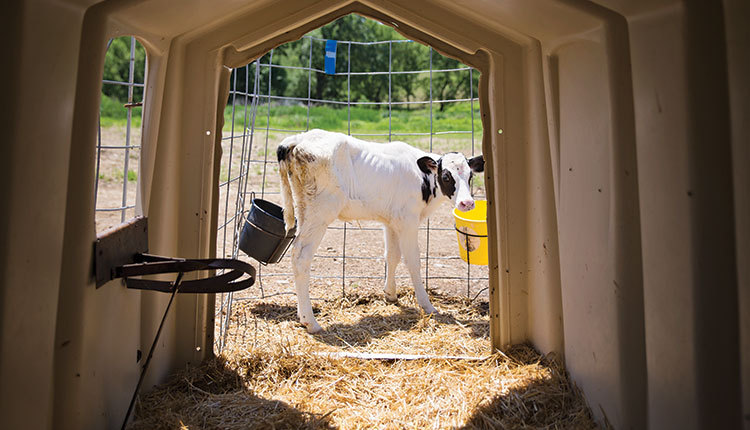The author is at the College of Veterinary Medicine, North Carolina State University, Raleigh.

There are products that can be added to milk or replacer that will help control crypto diarrhea.
Be prepared to use fluid therapy to keep calves hydrated.
Cryptosporidiosis is a common cause of diarrhea. It can be very frustrating to deal with since it occurs very commonly, is difficult or impossible to get rid of completely, and is not readily treatable. Specifically, cryptosporidiosis refers to diarrhea caused by the protozoal organism Cryptosporidium parvum. Disease caused by a protozoa is different than what we usually see in cattle. However, this is an important distinction.
Many diseases we normally deal with are caused by bacteria which often are treated with antibiotics. However, protozoal organisms generally are not killed by these drugs. Other major diseases of dairy cattle are caused by viruses. These infections usually aren't treatable with antibiotics, but they often are preventable by using vaccines (respiratory disease would be a good example). There are no effective vaccines for cryptosporidia, and vaccines that protect against protozoal organisms generally are very difficult to develop.
Cryptosporidial oocysts (eggs) commonly are shed by calves from 5 days of age until 3 to 4 weeks of age. Many will shed a few oocysts without having clinical signs of disease. However, high infection rates (greater numbers of eggs) leads to intestinal damage and diarrhea.
Oocysts shed by one calf can contaminate the environment including feed and water. Then these eggs are picked up by other calves, and the infection continues. So crypto most commonly is passed directly from calf to calf on farms and occasionally can be passed from calf to human.
Calves normally shed oocyts for about three to four days after they initially are infected, although sometimes shedding can continue for up to 10 days. However, once the infection is over, calves stop shedding oocysts. Since this is a disease that possibly can be passed to humans, this is an important point. Cattle do not become chronic carriers or shedders of these parasites, and the cryptosporidial organism that causes disease in people really only comes from young calves.
The exact way that cryptosporidial organisms damage the small intestine is complex and not completely understood. However, the organism damages the villi which line the small intestine and are responsible for absorbing fluid and nutrients. Following infection, the small intestine is not able to absorb nutrients properly, and diarrhea develops. Calves will appear lethargic, stop drinking milk, and eventually will become dehydrated. The diarrhea will persist for several days until the immune system clears the infection and the intestines are able to repair the damage done by the organism.
Crypto usually is fairly easy to diagnose in calves with diarrhea since the eggs can be easily seen under a microscope. Your veterinarian can take fecal samples from affected calves and should be able to tell you whether or not cryptosporidia are involved.
One of the more frequent questions I get is what can I do to treat calves with cryptosporidial diarrhea? Unfortunately, we still don't have a good answer for this.
There is a drug called halofuginone that is licensed for prevention of cryptosporidial infection in Europe where it is routinely administered for the first 7 days of life. Some studies have shown that using halofuginone can reduce the severity of diarrhea and the excretion of oocysts. However, other clinical trials have shown little to no benefit of halofuginone.
For example, one study done in bull calves showed no difference in the incidence of or treatment rates for diarrhea between the calves treated with halofuginone and those not treated. There was a significant delay in shedding of oocysts, but when halofuginone feeding was stopped, the treated calves began shedding oocysts again. There was no difference in milk intake, weight gain, or age at weaning between the treated and untreated groups. So, although it may be effective in reducing oocyst shedding while being fed to calves, it may or may not actually reduce diarrhea in calves.
In a study done last year at Cornell University, a drug approved for horses called nitazoxanide was able to reduce the duration of oocyst shedding and improve fecal consistency in calves infected with cryptosporidia. Although the initial study showed promise for possible use in calves with diarrhea, this product recently was pulled from the veterinary market and no longer is being produced.
Decoquinate (Deccox), which is labeled as a preventive for coccidiosis, is another product that has been looked at. However, studies using doses normally added to milk to control coccidiosis found no effect on cryptosporidia.
There is one product on the market that might be worth considering. In a small study done in Japan, an activated charcoal product with wood vinegar liquid was effective in stopping diarrhea and oocyst shedding in calves with crypto infections. This effect was noted within 24 hours of adding this product to the milk replacer. The activated charcoal with wood vinegar liquid is found in the product First Arrival that is sold in the U.S. It is available as a powder that can be added to milk or milk replacer and also as a paste that can be administered to calves directly. Although it remains to be seen if this product can help control crypto diarrhea in a large-scale field study, it may be worth considering.
There have been several attempts to produce a vaccine to control C. parvum infections, but none of these have been effective consistently. Studies using both vaccination of dry cows with whole organisms and vaccination of newborns with oral product prior to colostrum administration have been tried.
Help them out
So, treatment, in general, should be focused on fluid therapy to keep calves well hydrated as most calves will recover from cryptosporidiosis if there is not an overwhelming infection.
Since there are no vaccines to prevent crypto and no specific drugs available to kill the organism within the calf, controlling diarrhea comes down to good management. Sanitation and cleanliness are keys to minimizing severity of infection. However, once the environment becomes contaminated, this disease can be very difficult to overcome. There are several important control points.
1011_751

Be prepared to use fluid therapy to keep calves hydrated.
Cryptosporidiosis is a common cause of diarrhea. It can be very frustrating to deal with since it occurs very commonly, is difficult or impossible to get rid of completely, and is not readily treatable. Specifically, cryptosporidiosis refers to diarrhea caused by the protozoal organism Cryptosporidium parvum. Disease caused by a protozoa is different than what we usually see in cattle. However, this is an important distinction.
Many diseases we normally deal with are caused by bacteria which often are treated with antibiotics. However, protozoal organisms generally are not killed by these drugs. Other major diseases of dairy cattle are caused by viruses. These infections usually aren't treatable with antibiotics, but they often are preventable by using vaccines (respiratory disease would be a good example). There are no effective vaccines for cryptosporidia, and vaccines that protect against protozoal organisms generally are very difficult to develop.
Cryptosporidial oocysts (eggs) commonly are shed by calves from 5 days of age until 3 to 4 weeks of age. Many will shed a few oocysts without having clinical signs of disease. However, high infection rates (greater numbers of eggs) leads to intestinal damage and diarrhea.
Oocysts shed by one calf can contaminate the environment including feed and water. Then these eggs are picked up by other calves, and the infection continues. So crypto most commonly is passed directly from calf to calf on farms and occasionally can be passed from calf to human.
Calves normally shed oocyts for about three to four days after they initially are infected, although sometimes shedding can continue for up to 10 days. However, once the infection is over, calves stop shedding oocysts. Since this is a disease that possibly can be passed to humans, this is an important point. Cattle do not become chronic carriers or shedders of these parasites, and the cryptosporidial organism that causes disease in people really only comes from young calves.
The exact way that cryptosporidial organisms damage the small intestine is complex and not completely understood. However, the organism damages the villi which line the small intestine and are responsible for absorbing fluid and nutrients. Following infection, the small intestine is not able to absorb nutrients properly, and diarrhea develops. Calves will appear lethargic, stop drinking milk, and eventually will become dehydrated. The diarrhea will persist for several days until the immune system clears the infection and the intestines are able to repair the damage done by the organism.
Crypto usually is fairly easy to diagnose in calves with diarrhea since the eggs can be easily seen under a microscope. Your veterinarian can take fecal samples from affected calves and should be able to tell you whether or not cryptosporidia are involved.
One of the more frequent questions I get is what can I do to treat calves with cryptosporidial diarrhea? Unfortunately, we still don't have a good answer for this.
There is a drug called halofuginone that is licensed for prevention of cryptosporidial infection in Europe where it is routinely administered for the first 7 days of life. Some studies have shown that using halofuginone can reduce the severity of diarrhea and the excretion of oocysts. However, other clinical trials have shown little to no benefit of halofuginone.
For example, one study done in bull calves showed no difference in the incidence of or treatment rates for diarrhea between the calves treated with halofuginone and those not treated. There was a significant delay in shedding of oocysts, but when halofuginone feeding was stopped, the treated calves began shedding oocysts again. There was no difference in milk intake, weight gain, or age at weaning between the treated and untreated groups. So, although it may be effective in reducing oocyst shedding while being fed to calves, it may or may not actually reduce diarrhea in calves.
In a study done last year at Cornell University, a drug approved for horses called nitazoxanide was able to reduce the duration of oocyst shedding and improve fecal consistency in calves infected with cryptosporidia. Although the initial study showed promise for possible use in calves with diarrhea, this product recently was pulled from the veterinary market and no longer is being produced.
Decoquinate (Deccox), which is labeled as a preventive for coccidiosis, is another product that has been looked at. However, studies using doses normally added to milk to control coccidiosis found no effect on cryptosporidia.
There is one product on the market that might be worth considering. In a small study done in Japan, an activated charcoal product with wood vinegar liquid was effective in stopping diarrhea and oocyst shedding in calves with crypto infections. This effect was noted within 24 hours of adding this product to the milk replacer. The activated charcoal with wood vinegar liquid is found in the product First Arrival that is sold in the U.S. It is available as a powder that can be added to milk or milk replacer and also as a paste that can be administered to calves directly. Although it remains to be seen if this product can help control crypto diarrhea in a large-scale field study, it may be worth considering.
There have been several attempts to produce a vaccine to control C. parvum infections, but none of these have been effective consistently. Studies using both vaccination of dry cows with whole organisms and vaccination of newborns with oral product prior to colostrum administration have been tried.
Help them out
So, treatment, in general, should be focused on fluid therapy to keep calves well hydrated as most calves will recover from cryptosporidiosis if there is not an overwhelming infection.
Since there are no vaccines to prevent crypto and no specific drugs available to kill the organism within the calf, controlling diarrhea comes down to good management. Sanitation and cleanliness are keys to minimizing severity of infection. However, once the environment becomes contaminated, this disease can be very difficult to overcome. There are several important control points.
- Provide a clean, dry area for cows to calve, and separate the calf quickly.
- Make sure calves are getting an adequate amount of good quality (clean) colostrum. Although this may not be able to prevent crypto infections, it certainly will help prevent secondary invaders such as rotavirus or coronavirus from making the diarrhea worse.
- Maintain strict sanitation with feeding equipment (bottles, buckets, and nipples).
- Use appropriate disinfectants like 5 percent ammonia or oxine when cleaning hutches or pens.
- Move calves that develop diarrhea away from others. Remove their manure thoroughly before others are placed into the same hutch or calf pen.
- Feed sick calves last since you easily can spread crypto from sick calves to healthy calves on your boots or on feeding utensils like bottles or nipples.
- Learn to identify calves with diarrhea quickly, and start them on an appropriate course of treatment usually involving oral electrolytes.
1011_751











